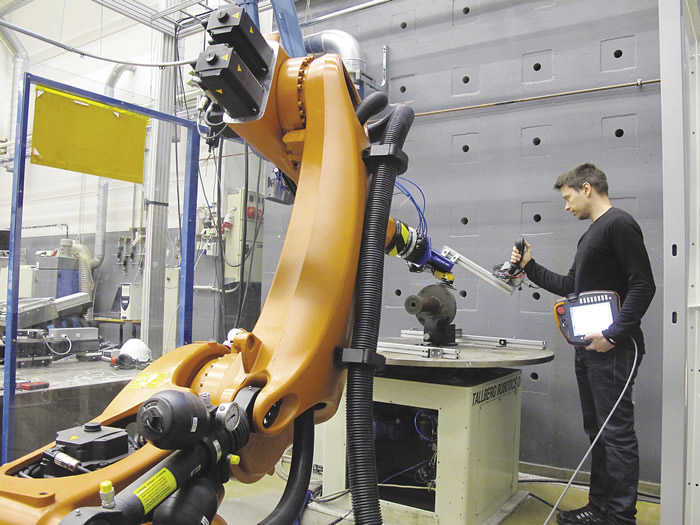Teach your robot well
A new control system can reduce the time to set up and program industrial robots from an hour or more to just minutes, according to the Finnish research organization that developed it.
How? Normally, a robot’s work path is programmed slowly, one point at a time. But the new system allows the use of a joystick to guide a robot arm along the paths required for grinding and other operations, thereby “teaching” the robot how to work on its own, explained Tapio Heikkilä, principal scientist at the VTT Technical Research Centre of Finland Ltd.
Unlike conventional robotic-guidance systems, which are equipped with only one force/torque sensor or none at all, the VTT system has two. One sensor is attached to the wireless control stick that guides the robot, while the second detects the amount of pressure being placed on the tool the robot is wielding.


VTT says its wireless joystick controller makes programming continuous paths for a robot arm quick and easy. Image courtesy VTT Technical Research Centre of Finland.

“With this additional second sensor, we get a feeling of how strongly the operator is pressing the tool against a surface,” Heikkilä said. “When programming paths, these contact forces can be tracked and recorded. This is a major change from current commercial systems.”
The stick and control work together in real time, allowing an operator working in the same space as a robot to control the robot’s movements directly via the stick. In addition to programming a nearby robot, an operator could use the system to control a robot performing a specific task, such as handling heavy loads on the factory floor. With the operator steering the robot just a short distance away, both the teaching of new tasks and direct control of the robot become much faster, according to VTT.
Heikkilä said the control system is “close” to being ready for commercial use. Once it is, the system will be aimed mainly at industrial robots used in short production runs of single-item products. Another possible application is repair work.
For more information about the VTT Technical Research Centre of Finland Ltd., visit www.vttresearch.com or call +358-20-722-7070.
Related Glossary Terms
- grinding
grinding
Machining operation in which material is removed from the workpiece by a powered abrasive wheel, stone, belt, paste, sheet, compound, slurry, etc. Takes various forms: surface grinding (creates flat and/or squared surfaces); cylindrical grinding (for external cylindrical and tapered shapes, fillets, undercuts, etc.); centerless grinding; chamfering; thread and form grinding; tool and cutter grinding; offhand grinding; lapping and polishing (grinding with extremely fine grits to create ultrasmooth surfaces); honing; and disc grinding.







